Surges and transients are classified into two categories depending on their source of origin 1) External and 2) Internal. External surges enter the facility from outside, such as Lightning strikes, Utility grid switching etc. Internal surges originate inside the facility from the non-linear load switching. Ex: Load switching, AC-DC power conversion, inrush current from motors. Both the internal and external surges cause instantaneous damage to the electrical loads, altering the efficiency and performance of the system. Researches indicate that 70-85% of the total surges are internal, while 15-30% are external.
External Surges
The two most important sources of externally generated surges are 1) Lightning strikes and 2) Utility company switching.
Lightning Strikes:
The lightning can take two ways to enter the facility main panel – 1) direct strike on the facility through air 2) indirect strike through the ground.
Direct strike:
The direct strike on the facility is extremely rare (3-5% of the lightning-related damages), but this could leave severe damage to the roof and the electronics inside the house. While the direct strike on a facility is through the air, a direct strike on an electric pole or overhead line can transmit the surge through the powerlines. A traditional SPD (surge protective device) or any power quality equipment can not stop the direct strike surge. Traditionally, surge arrestors and grounding rods are used to divert the surge from the roof to the grounding rod.
Indirect strike:
The more common scenario in tropical weather is a nearby lightning strike hitting the ground (95-97% of the lightning-related damages) – an indirect strike entering the facility. The indirect strike takes the ground path (via underground pipes, electrodes, phone/internet/cable wires) to enter the facility. The indirect strikes are less severe than the direct hits and can be stopped using a ground filter or a sophisticated SPD.

The following image shows the entrance paths of lightning surge into a facility.
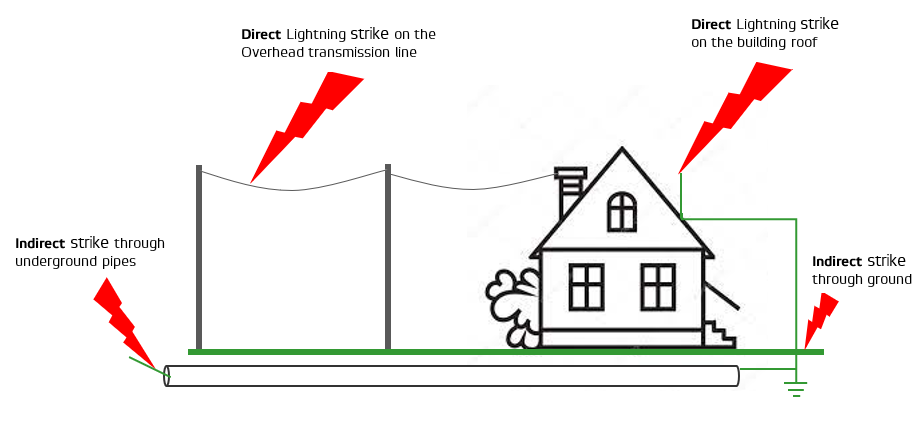
Utility company switching:
The other standard method of externally generated surges is utility switching. The sudden start and stop of the services due to power outage, blackout/brownouts, sags, and overload will result in severe surges in the order of thousands of volts. The majority of the utility-related surges enter the facility through the powerlines. A suitable SPD and proper grounding can protect the facility from these externally generated utility-related surges.
Internal Surges
The majority of the surges (70-85% of the total surges) are generated by the electrical loads in the facility. Today’s electrical loads are non-linear, with a working principle of “switching”. The switching is a phenomenon in which the load constantly changes its operating voltage, ex: AC to DC and DC to AC. The load generates unwanted electrical noise called “switching noise” during the switching process. The unattenuated switching noise resonates in the facility, amplifying it further to cause “internally generated surges”.
The other source of internally generated transients is the inductive coupling and inrush current. Magnetic materials such as motors and transformers work on the principle of inductive coupling. Inductive coupling induces/transfers voltage from the primary to the secondary winding, inducing voltage transients to the power lines. In addition to the coupling, the magnetic loads often require a high amount of inrush current for their operation, leaving residual voltage and current transients to the system.
The damage caused by the surges
Externally generated surges and transients are high in amplitude but are only up to 15% of the total surges. Internally generated noises are prevalent in any facility and constitute up to 85% of the total surges/transients. Due to the extremely high voltage levels, the external transients could instantly burn the loads down to ashes. However, the internal transients may not be large enough to burn the loads instantly, but they will negatively affect the system’s power quality over a period of time. The transients alter the load’s capacitance, resulting in erratic behavior or premature damage. The transients also increase the load’s operating temperature, causing a significant increase in loads’ power consumption. The following table shows the differences between externally and internally generated transients.
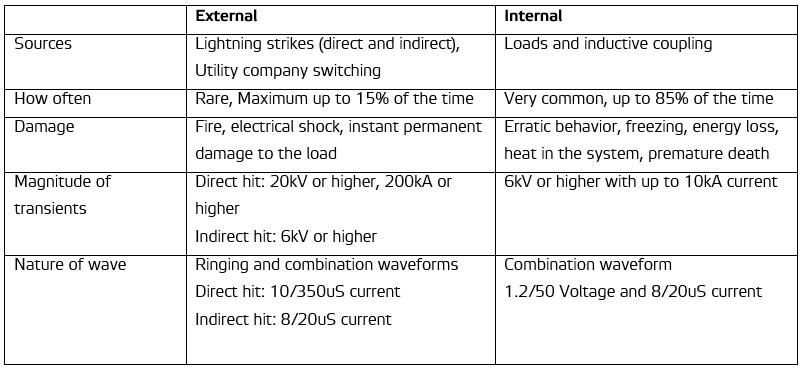
Use of an SPD for surges
The surge protection device (SPD) consists of overvoltage protection circuits, mainly using Metal Oxide Varistors (MOV). MOV is a nonlinear resistive element that shorts in the event of a specified overvoltage. By shunting (diverting) massive surge energy into the ground, the SPD clears the rest of the power system from surges/transients. The shunting of energy usually takes place to the ground at the main panel. The following picture shows the typical shunting of surge energy using a traditional SPD. (Image source: RF Wireless World)
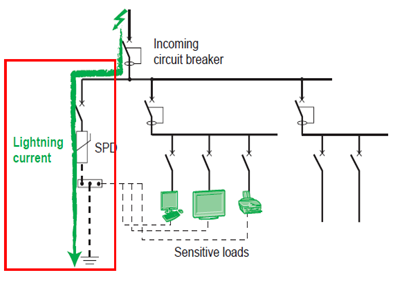
A critical feature of a transient/surge is that they often are ring noises. Ring noise is a bipolar damped oscillating wave as shown in the following figure (Image source: IEEE)
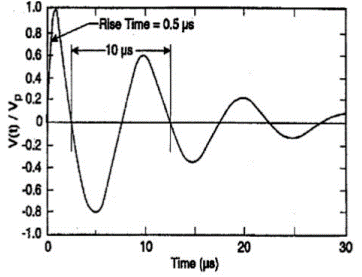
The MOVs in an SPD divert the overvoltages (only) to the ground, but not the residual ringing noise. The residual ringing noise often self-magnifies (resonates) high enough to cause damage to the loads. The damage may not be instantaneous, but it is large enough to create power quality issues such as erratic behavior, premature death, increased heat, and energy losses in the system.
A Perfect solution for surges and transients
An SPD at the main panel may be a good solution for the combination waves and the externally generated surges at the building’s main entrance. But they may not solve the internally generated transients that are ring waves and combination waves. The facility needs a self-healing thermal-based MOV along with a filtration circuit that can quickly attenuate the residual ringing noise, therefore protecting the load from noise and transients. EP’s patented circuit uses:
1) Thermal-based Metal Oxide Varistor for its surge protection device circuitry, complying with UL 1449 3rd Ed to remove externally generated surges and transients.
2) Waveform correction and low pass filter circuits continuously remove the switching noise / higher-order harmonics generating internal to the facility.
The following measurement shows the effectiveness of EP technology over traditional SPDs (CH and PSY).
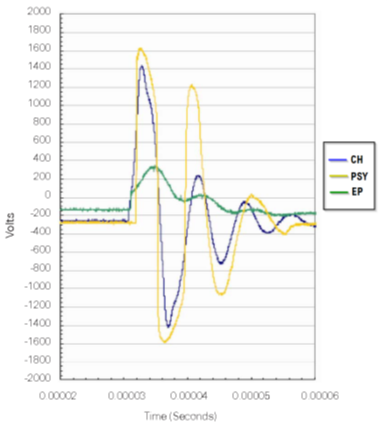
As seen in the above measurement, the EP unit did not leave any residual ringing noise to the system with the help of its internal waveform correction technology. The other two filters, CH and PSY, leave out tremendous ringing noise/transients back into the system, potentially damaging the loads permanently.
Environmental Potentials is proud to offer a complete line of products to meet the needs of any electrical environment. EP is committed to maintaining the highest standards in the manufacturing process to ensure every product exceeds the customer’s expectations. With industrial, commercial, communication, and residential applications, Environmental Potentials has a solution for businesses, governments, and homes of all shapes and sizes. Contact us at info@ep2000.com for any questions you may have.

